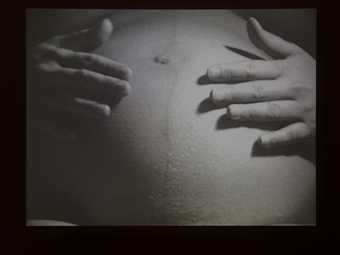Responses to the rising sense of political crisis through the 1970s provided a potent arena in which to address the role of art in society. Artists associated with conceptual art began engaging with issues of representation, labour and gender – often to polemical ends. Two themes were prominent; opposition to the anti-union legislation and rising unemployment under the Conservative government of Edward Heath, and at the same time the growing awareness of the need to advance the rights of women in the workplace. This repurposing of conceptual art was in some ways a return to original principles seeking a close re-engagement with the wider world.
Mary Kelly
Antepartum 1973
Film, 8 mm transferred to DVD, black and white, no sound
90 second loop
Courtesy the artist and Pippy Houldsworth
Antepartum is a single close-up shot that records the artist stroking her abdomen, at full term, as the unborn baby moves. In 1978, writing about the film Sarah Kent noted:
First of all it is an assertion of female creativity and intelligence; secondly an analysis of the process of socialisation by which, she believes, women are taught to regard themselves as intrinsically second rate; and thirdly a fusion of the “feminine” role of motherhood and the “masculine’ one of making art.
Kelly was among a group of artists in London who were influenced by the experimental film movement, and notions of real time and duration are central to Antepartum’s repetitive gesture. The film was a prologue to Kelly’s iconic Post-Partum Document.
Conrad Atkinson
Industrial Relations Bill 1971
Film, 16mm transferred to DVD, colour, no sound
3 minutes
Courtesy the artist
Conrad Atkinson made this film in response to the Conservative government’s Industrial Relations Bill of 1970 (the Act of 1971), which restricted trade unions rights and led to strikes by dock workers and miners.
Atkinson’s film is symbolic and enigmatic, and sees the artist walking across different landscapes and holding different signs that reproduce the surrounding environment. On other occasions Atkinson used film to document specific industrial disputes, such as that at Brannan Thermometers factory in Cleator Moor.
The film was included in the exhibition Art Spectrum London held at the Great Hall of Alexandra Palace in August 1971.
Darcy Lange
Social Consideration, Communication and Observation 1971
A woman putting out her washing in London
Film, 8mm transferred to video, colour, no sound
3 minutes
A Documentation of Bradford Working Life, UK 1974
First Situation. 2nd Study: The Grinding
The Second Situation. 2nd Study: Traditional Combing
The Third Situation. 1st Study: The Verson Press
Fourth Situation. 1st Study: Study of a Packer
Film, 16mm, video, sound, black and white
32 minutes
Waitara Freezing Works, Taranaki 1974
Boning Calves
Video, black and white, sound
10 minutes
Cantavieja, Study of Work in a Spanish Village, Spain 1975
Scything Wheat
Video, black and white, sound
7 minutes
All works courtesy of Darcy Lange Estate and Govett-Brewster Art Gallery, New Zealand.
Darcy Lange’s singular body of work brought issues from conceptual art to film and video, but stood outside of the increasingly closed spheres defined by emerging theories of video art and structural/materialist film. Lange’s projects reflected on feedback, process and the constituent elements of installation practice.
Lange’s systematic studies of working life reflected his fascination with British class and power structures. For example, his studies of work in Bradford’s factories became performance analysis; they searched the monotony of the work. Lange’s critical practice was based on duration, the interrelationship of media and a desire to effect social change. In this respect, Lange sought ‘to prevent what I make from becoming an end in itself – not dissimilar to the loved art object’.

